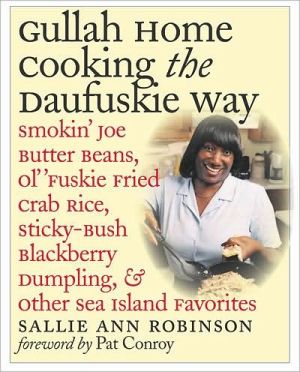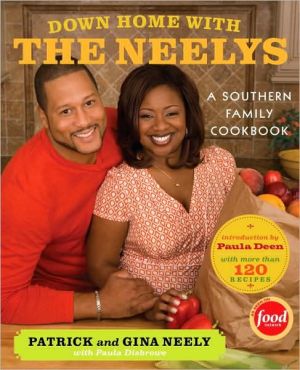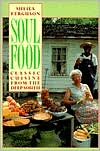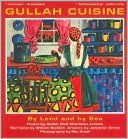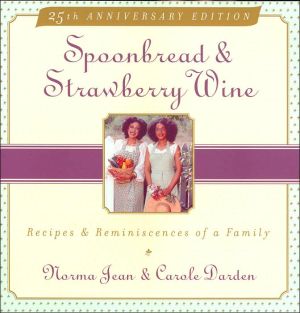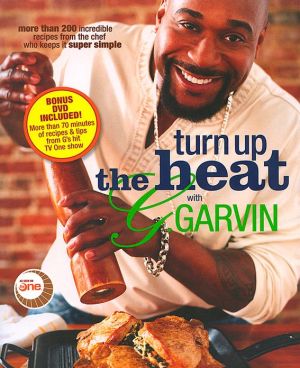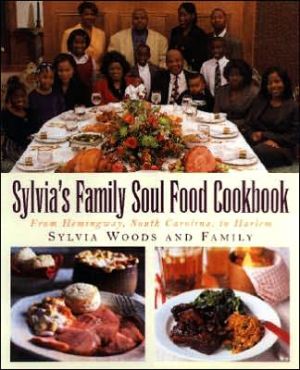Gullah Home Cooking the Daufuskie Way: Smokin' Joe Butter Beans, Ol' 'Fuskie Fried Crab Rice, Sticky-Bush Blackberry Dumpling, and Other Sea Island Favorites
"If there's one thing we learned coming up on Daufuskie," remembers Sallie Ann Robinson, "it's the importance of good, home-cooked food." In this enchanting book, Robinson presents the delicious, robust dishes of her native Sea Islands and offers readers a taste of the unique, West African-influenced Gullah culture still found there.\ Living on a South Carolina island accessible only by boat, Daufuskie folk have traditionally relied on the bounty of fresh ingredients found on the land and in...
Search in google:
"If there's one thing we learned coming up on Daufuskie," remembers Sallie Ann Robinson, "it's the importance of good, home-cooked food." In this enchanting book, Robinson presents the delicious, robust dishes of her native Sea Islands and offers readers a taste of the unique, West African-influenced Gullah culture still found there. Living on a South Carolina island accessible only by boat, Daufuskie folk have traditionally relied on the bounty of fresh ingredients found on the land and in the waters that surround them. The one hundred home-style dishes presented here include salads and side dishes, seafood, meat and game, rice, quick meals, breads, and desserts. Gregory Wrenn Smith's photographs evoke the sights and tastes of Daufuskie. "Here are my family's recipes," writes Robinson, weaving warm memories of the people who made and loved these dishes and clear instructions for preparing them. She invites readers to share in the joys of Gullah home cooking the Daufuskie way, to make her family's recipes their own.The New York TimesRobinson knows what to do with classic soul food ingredients like pig's feet, ham hocks, chitterlings and even possum. But Southern food lovers will also find plenty of down-to-earth recipes for dishes like crab rice, fried shark, a variety of roasts and stews, ribs and oysters. — Dwight Garner
Gullah Home Cooking the Daufuskie Way\ Smokin' Joe Butter Beans, Ol' 'Fuskie Fried Crab Rice, Sticky-Bush Blackberry Dumpling, and Other Sea Island Favorites \ \ By Sallie Ann Robinson \ The University of North Carolina Press\ Copyright © 2003 University of North Carolina Press\ All right reserved.\ ISBN: 978-0-8078-5456-3 \ \ \ \ Introduction\ When midwife Sarah Grant rushed over the plank across the swamp near Grandmomma's some 40 years ago, she was about to bring me into a world very different from anything that exists today. \ Married to Daufuskie's undertaker (the Grants got us coming and going, folks used to say) Miz Sarah was the last of our small island's midwives. Her world, the one she introduced me to, was set for some big changes-but not before I learned its ways.\ Folks on our island had little money, but we had a thriving economy and a rich life. Unlike children today, my sisters and I didn't have a long list of things we wanted from somewhere and someone else. We didn't know about them. But what we did know-the yard, the garden, the woods, the river, and our community of neighbors-gave us all we needed, and, it seemed, all we could want. By the time I was grown, much of that, including most of our neighbors, would be gone.\ Island Life\ The Sea Islands along the South Carolina and Georgia coasts-with their unique landscape, climate, culture, and history-have, time and again, caught and lost the attention of the world. Daufuskie is one of those small islands. From Bloody Point beach on its south end, you can see Tybee Island, Georgia; Hilton Head Island, South Carolina; and between them, the Atlantic Ocean. Without a bridge to either of those resort islands or the nearby mainland, Daufuskie is remote, yet it has always been within reach, just a short boat ride away.\ Saltwater marshes wrap around the west and south sides of the island. Fish, crabs, shrimp, oysters, and just about every other sea life you can imagine breed, grow, and live in the tidal creeks and rivers that snake through the marshes. Palmetto trees rattle in the breeze and stand against all but the meanest hurricane winds. Tall pines and ancient live oaks hold the mystery of generations gone in their beards of Spanish moss and frocks of resurrection ferns. Snakes, rabbits, coons, small island deer, foxes, and probably a few bobcats still wander the thick underbrush of sparkleberries, wax myrtle, and briars. Shopping trips-for all but the barest necessities-call for a boat.\ Life moves a little slower.\ And when I was coming up on 'Fuskie (as we call our home), life moved a lot slower. Running water, when I was a child, came from a hand pump in the kitchen or yard. Half the bathroom was out back: the other half was a galvanized washtub in the kitchen-or in the yard on a hot summer afternoon. If you didn't own a boat-and we didn't-you had to plan your shopping trips for when you could catch a ride. For a few years, there was a government-funded public ferry service aboard surplus military boats, but the boats weren't very reliable. Some of our neighbors had old, wooden bateaus with small motors that would putt along the creeks that wound through the marshes. And sometimes we could ride along or send a list to Messex store in Bluffton, South Carolina, where we kept an open account, or to Hester and Zipperer feed and seed in Savannah.\ But most of our food came from the land-and water-around our tin-roofed home. We tended a big garden, four seasons of the year in Daufuskie's mild weather. We raised chickens, hogs, and cattle in our yard. We gathered berries and trapped or sometimes shot animals in the woods. We fished, crabbed, shrimped, and picked oysters. We didn't always have a lot, but we always had enough.\ Yondah Times\ I remember so well my childhood days on Daufuskie in the 1960s and 1970s. While the rest of the country was fighting over civil rights and the war in Vietnam, we were living much the way our great-grandparents had at the turn of the century. While kids elsewhere watched TV or went to the movies, we listened to the Supremes and the Temptations on battery-powered radios under the glow of oil lamps.\ But it's not as if the world never knew Daufuskie. Off and on, the island has played important economic, even historic, roles. But when I was coming up, the world was dancing, for the most part, without us.\ Records of life on Daufuskie date back to the late 1600s, when European explorers began building settlements in the rich woods of the South Carolina Lowcountry. On Daufuskie and other islands, they found shell rings and mounds left by forgotten Native Americans. Bloody Point, the island's southeast corner, earned its name in a pair of battles during the Yemassee War in the early 1700s. After the defeated Yemassee Indians left the area for Florida, colonial planters shipped timber, indigo, and cotton back to England to fuel the Industrial Revolution. During the American Revolution, Daufuskie's Tory planters, loyal to the British king, raided the plantations of patriots on nearby Hilton Head, and were, in turn, attacked by the patriots.\ Daufuskie grew quickly as part as the young United States. Plantations, built by slaves and cut off by water from the rest of the world, grew timber, cotton, and the unique Gullah culture. The Civil War ended the plantation economy, but the Gullah people stayed, farming the subdivided lands of former plantations and fishing the creeks around the island.\ During the last years of the nineteenth century and the early part of the twentieth century, Daufuskie was an important stop for ferries that cruised the inland waters around the Sea Islands of South Carolina. An oyster canning factory at Bennett's Point made the island somewhat famous. (You can still buy "Daufuski" brand oysters in red cans that are now packed in Korea.) Folks, mostly the descendants of slaves, had jobs at that factory, timbering, or on the boats that hauled oysters, fish, produce, and people. Others farmed their land, trading vegetables, eggs, and meat for goods at several island stores. The stores would sell the produce to other islanders-as well as to folks on the mainland. My grandfather worked for years, at a dollar a day, on a dredge that kept the inland creeks open. At one point, more than 1,000 people lived on Daufuskie. Few folks got much ahead, but most got by.\ In the 1950s, growing industry along the nearby Savannah River polluted many of the marshes and creeks around Daufuskie. Health officials closed most of the valuable oyster beds. There was little work and almost no money, so most folks left the island. One by one, the stores closed.\ Islanders who stayed, like my parents and grandparents, loved Daufuskie and its laid-back living. Some folks knew well that corn was good for making more than meal and grapes for making more than jelly. The easy island lifestyle slowed even more. When I was a child, no more than 200 people remained on the island. Two thriving churches dwindled to one struggling parish. The two-room Mary Field School struggled to educate several dozen children, including me, through the eighth grade. White folks, other than rich men who came to hunt and fish in the winter, were few.\ Times Come a Changin'\ When I was in the seventh grade, Pat Conroy, then a young, idealistic teacher, came down from Beaufort (the seat of Beaufort County, South Carolina, which includes Daufuskie) to help Miz Johnson, our local teacher. He taught us things in ways we could never have imagined-and I will never forget. We learned about outer space through a telescope. Instead of having us sit in the classroom all day, he would quiz us as we ran down the beach. He took us on field trips to Washington, to see the Harlem Globetrotters in Savannah, and to go trick or treating in Beaufort. We acted out A Christmas Carol, instead of just reading it. The words in our books described a wide world we couldn't see from Daufuskie. Pat showed it to us.\ All this didn't sit well with Miz Johnson or the Beaufort County School District. But it did change our lives, and for Conroy the experience resulted in the novel The Water Is Wide, which was made into the movie "Conrack."\ But with or without Pat Conroy, life on Daufuskie was about to change again. Although my family and many others like us owned property on the island, several large plantation properties remained mostly intact. The owners, who lived hundreds or thousands of miles away, grew timber and leased the properties for hunting. But as my sisters and I were growing up, so was nearby Hilton Head. Real estate developers looked across the water at Daufuskie and saw an island that seemed perfect for exclusive resorts, spas, golf courses, riding stables, and big profits. By the mid-1980s, two large properties-Melrose and Haig Point plantations-were under development.\ I remember my mother fussing at big trucks as they rumbled by the house, spraying dust on her freshly hung laundry. Big houses sprang up on small lots, laid out along freshly turned sand that would soon be golf courses. Horses came back to the island, but the new animals lived in fancy stables, ate fancy feed, and had fancy saddles. Ferry service returned, but unless you were a property owner or a club member or employee, you usually weren't welcome aboard. Tour boats came, telling their passengers tall tales of island life.\ Although a few of us worked for our new neighbors, more islanders, especially the young, left to find jobs and schools across the water. I left (although I plan to move back), as did most of our neighbors and all but a few of our relatives. Only a couple dozen native islanders remain. Some of these folks still sell their famous deviled crabs, as we did when I was a child, to tourists as they come ashore on the Bennett's Point or Cooper River docks.\ If you have patience and a sharp eye, you can still find prehistoric shark's teeth and arrowheads along the eroding shores of Daufuskie. And along the back roads of the island, you can still hear a few folks talking in the rhythms of Gullah. But even as that blend of African and English is washing away like the shore, you can still have a taste of 'Fuskie in a forkful of Pop's smuttered mullet or Sea Island okra gumbo.\ Food is life. And the way we lived, life was gathering, growing, and preparing food. For some readers, the tales and recipes in this book will seem like memories. For others, they'll be discoveries. But whether you grew up in a high-rise or a tin-roofed shack, the meals described here will sho'nuff stick to your ribs.\ Living and Cooking on 'Fuskie Time\ If there's one thing we learned coming up on Daufuskie, it's the importance of good, home-cooked food. Ingredients were plentiful on our island, but (except for the very old, the very young, the sick, and the shut-in) we had to earn our meals. Without our hard work-growing, gathering, and catching-we had nothing much for our table.\ That doesn't mean anyone went hungry. If you were walking down a road or path and smelled the 'roma of fresh cornbread, lima beans, and fried chicken, you could follow your nose to a good meal. And you were always welcome. Sharing from one hand to another made good meals available to all.\ 'Fuskie folks have known their way 'round the stove for generations. But while most all of us in my family were cooks from the time we could see over the edge of the stove, Momma ran the kitchen. She would fix up a big breakfast and usually cooked our afternoon dinner, which we would eat between 3:00 and 5:00, depending on the day's work. Most times, we didn't have any lunch, or if we did, it was just a snack. If Momma wasn't home, was tired of cooking, or didn't want to cook what we wanted to eat, Pop, my sisters, or I might cook dinner. Pop especially liked to cook shrimp and fish still jumping from his "mullet hole" in the creek.\ Even though he cooked himself, Pop always reminded us cooking was woman's work. "If ya wanna keep ya a good man," he used to tell my sisters and me, "ya gotta know how to cook a good meal."\ We planned most meals a day or more ahead because we had to gather and prepare the ingredients before we could fix the meal. We also had to cut and haul wood for the stove and pump water, carrying full buckets inside. We kept a stack of firewood drying behind the stove, and five-gallon buckets of water, covered with lids, sat on the corner table near the stove. After dinner, we refilled the buckets and brought in more wood so Momma would have supplies handy for breakfast.\ There was a season for almost everything: a time to catch different seafood, a time to butcher the hog or cow, a time to plant and harvest each crop, a time for hunting each animal. Each nut, fruit, and berry ripened in its own time.\ And it was always firewood season. Keeping our stove hot was no small chore. Every two weeks or so, we hitched Bobby the cow to the wagon and headed, as a family, into the woods. Pop swung his ax to chop deep into the trees on the side where he wanted them to fall. My sisters and I took turns at either end of our big, crosscut saw. We cut the trees down, then into sections that fit our wagon. If Momma didn't have to tend a meal cooking at home, she helped, too, picking up pine branches and cones for kindling, and loading the firewood. There was still more work when we got the wood home. We had to cut it into usable logs, stack them, and carry in wood for the evening meal. These chores would last nearly all day, summer and winter. Of course, we needed more wood for heat in the winter, but the cookstove had to be fired up year-round.\ Getting food from the store-such as the big sacks of flour, grits, and rice that were our staples-meant hitching Bobby to the wagon, riding down to the landing, tying Bobby to a tree near some good grass, and boarding the ferry or a neighbor's boat. On the other side-Savannah, Hilton Head Island, or the small town of Bluffton-we had to find a ride to the store and one back to the landing. Then, after a long boat ride, at the end of a long day, we had to hitch up Bobby, load the wagon, and head home along dirt roads.\ We weren't wealthy, but we were well fed and we were certainly clean. We washed ourselves, with Momma making sure we scrubbed every nook and cranny. We washed our pots, dishes, forks, and spoons with water heated on the stove. And when black soot from our woodstove built up on our pots, Momma would send us out back to shine them with sand and crumbled bricks. We washed all our food completely before cooking. And we cooked everything thoroughly. Our meat wasn't pink, and our vegetables weren't crunchy.\ We worked hard and we got dirty. But when we got up each morning, we put on clean clothes. "Ya nevah know who gonna drop by," Momma would say, as we gathered the dirty clothes and she boiled up water in a big, black pot out back. Twice a week, Momma made us take turns scrubbing clothes on the washboard and hanging them on her half dozen clotheslines strung across the side yard. Then we had to heat the heavy iron on the stove and press our frocks on her homemade ironing board, propped between a chair and a table, in the kitchen. Flour and water boiled on the stove on laundry days, and we stirred it constantly, so our "starch" didn't lump up.\ Although Pop would cook his fish whenever he wanted it, Momma usually started dinner right after breakfast. We called such meals "long pots." Many of the recipes in this book can be cooked that way, for several hours over low to medium heat, which was just about the only kind our woodstove gave us. Momma would join the rest of us when we worked near the house. But if the day's work wasn't in the yard, the nearby fields, or the woods, we were on our own, because she couldn't leave the stove untended. When all our chores were done for the day, we didn't have to wait for our dinner.\ As my parents used to say, hard work and a little sweat never hurt anyone. And they didn't hurt me-much. I remember the play that mixed with our chores, the good ol' 'romas from the kitchen, and how a good, hardy meal filled my empty belly.\ Spoken Language on Daufuskie\ In the past 20 years, Gullah-'Geechee culture and language have drawn lots of attention. Professors have researched how English and African phrases mixed on the Sea Islands along the Georgia and South Carolina coasts. African leaders have visited St. Helena Island (a dozen miles, by water, north of Daufuskie), highlighting the connections between continents and peoples. Annual gatherings in Beaufort, on Hilton Head Island, and on Georgia's Sapelo Island celebrate a fading language and way of life.\ But my sisters and I never knew we were Gullah. I remember the first time some tourists asked me if I could speak Gullah. I asked back, "What be dat?"\ For most of my life, I've tried to adjust the way I speak to the folks I'm speaking to. Day to day, I measure every phrase before I say it, and some things just don't come out right. But when I get back with 'Fuskie folks, my words come easily.\ (Continues...)\ \ \ \ \ Excerpted from Gullah Home Cooking the Daufuskie Way by Sallie Ann Robinson Copyright © 2003 by University of North Carolina Press. Excerpted by permission.\ All rights reserved. No part of this excerpt may be reproduced or reprinted without permission in writing from the publisher.\ Excerpts are provided by Dial-A-Book Inc. solely for the personal use of visitors to this web site. \ \
\ The New York TimesRobinson knows what to do with classic soul food ingredients like pig's feet, ham hocks, chitterlings and even possum. But Southern food lovers will also find plenty of down-to-earth recipes for dishes like crab rice, fried shark, a variety of roasts and stews, ribs and oysters. — Dwight Garner\ \ \ \ \ Publishers WeeklyThe Gullah people of the Sea Islands of South Carolina have preserved ways of life and speech from West African slave culture and plantation times. Robinson, a native of Daufuskie, one of the islands, writes that "most of our food came from the land-and water-around our tin-roofed home." This book honors a love of her childhood and her family, and that love is intertwined with food. Introducing most recipes are reminiscences of loading the wood stove, trips to the store, fishing for sheepshead, washing clothes on a washboard and cooking "long pots" (slow-cooked meals). Beautiful photos of island life and a relaxed attitude toward cooking ("these are recipes, not rules") make for accessible additions to anyone's Southern repertoire, with homespun dishes like Tada Salad, Sea Island Okra Gumbo and Fuskie Crab Patties. Sticky-Bush Blackberry Dumpling and Crackin' Conch and Rice are the kind of authentically regional recipes that are harder and harder to come by these days. Pot Full O' Coon and Fried Squirrel may not be the next trendy item on a Manhattan menu (Robinson admits she doesn't cook possum anymore), but these are the recipes that give the book its unique, almost anthropological intrigue. Given that many recipes begin with bacon or pork fat, this is not a cookbook meant for nouveau palates as much as it is for the preservation of a unique, fascinating culture. Wonderful to browse through and experiment with, this is an excellent volume for anyone interested in Southern and African-American culture and food. (Mar.) Copyright 2003 Cahners Business Information.\ \ \ Library JournalRobinson grew up on Daufuskie Island, off the coast of South Carolina, which Pat Conroy wrote about in The Water Is Wide. In fact, she was one of his students in that two-room schoolhouse some 30 years ago. With Smith, Robinson recalls growing up on this isolated island, where her hardworking mother and father struggled to raise their 12 children. But her memories are of a happy childhood and a strong, supportive family, not of deprivation ("We didn't always have a lot, but we always had enough," she says). Meals depended on what there was in the garden, the ocean waters, and the farmyard, and they were simple but tasty: Hand-Picked Cucumber and Tomato Salad, Pop's Smuttered Mullet, Down-Home Chitlins. Robinson's stories come from another era (the map of Daufuskie today shows that much of the island has been taken over by gated communities for rich people from the mainland, and only a few natives still live there), and her memoir provides a warm, touching account of a time gone by. For area libraries and most collections on regional American fare. Copyright 2003 Reed Business Information.\ \ \ \ \ From the Publisher"Sallie Ann Robinson cooks slow and local—from the heart."\ — Damon Lee Fowler, Garden & Gun\ "A fascinating cookbook. . . . Robinson knows what to do with classic soul food ingredients like pig's feet, ham hocks, chitterlings and even possum. But Southern food lovers will also find plenty of down-to-earth recipes."\ — New York Times Book Review\ "Opens the front door of Robinson's garden and childhood and welcome[s] you right in."\ — Chicago Tribune\ "With this collection of recipes, stories, and personal reminiscences, Sallie Ann has cooked up a big pot of steaming low-country gumbo. So you better come on in her kitchen and experience the seasonings and flavors of the traditional and new Daufuskie Island offered up by a native daughter.\ (Vertamae Grosvenor)"\ \ \
